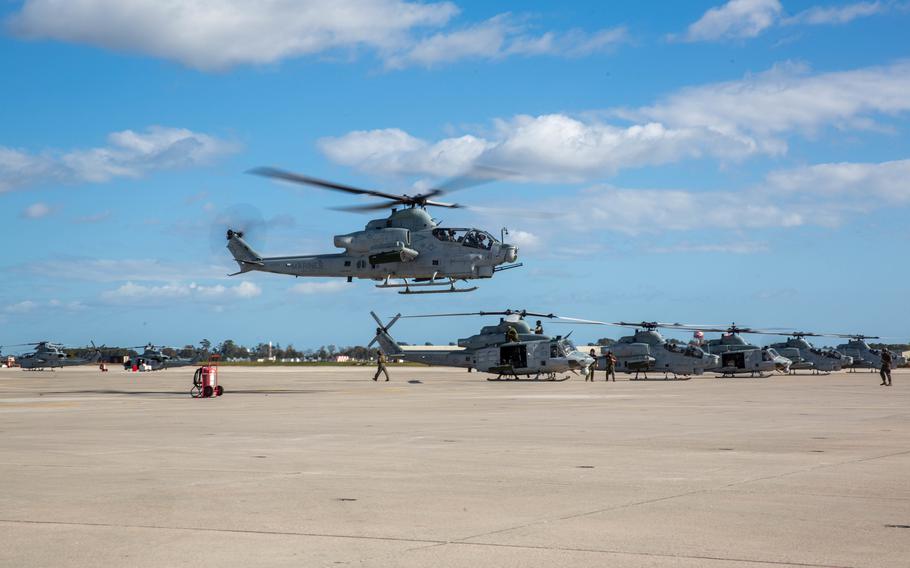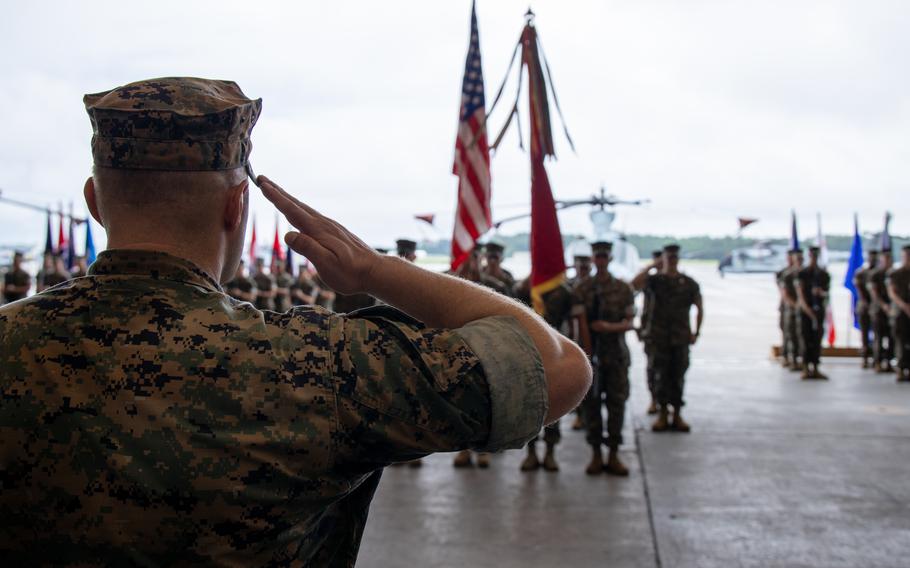
A U.S. Marine Corps AH-1Z Viper, assigned to Marine Light Attack Helicopter Squadron (HMLA) 269, taxis for the squadron’s final flight at Marine Corps Air Station New River, N.C., Nov. 7, 2022. This was the last flight for HMLA-269, which is deactivating in accordance with Force Design 2030. HMLA-269 is a subordinate unit of 2nd Marine Aircraft Wing, the aviation combat element of II Marine Expeditionary Force. (Servante Coba/Marine Corps)
WASHINGTON — An ongoing need for attack helicopter squadrons led the Marine Corps to revive a unit this week, less than two years after it was deactivated, service officials said.
The Marine Corps bid farewell to its Light Attack Helicopter Squadron 269, known as the “Gunrunners,” in December 2022 as part of a service-wide overhaul. But the farewell was not so final, lasting just 18 months.
The squadron, which is part of North Carolina-based II Marine Aircraft Wing, was reactivated Monday, July 1 after the Marine Corps conducted an analysis on force management. The analysis found there was a need for an additional attack helicopter squadron on the East Coast to support the II Marine Expeditionary Force, one of three Marine air-ground task forces meant to deploy overseas in response to conflict and crises. The second expeditionary force is based at Marine Corps Air Station New River, and the first and third are at Camp Pendleton and Okinawa, Japan, respectively.
“With persistent demand for light attack and utility aviation support, the [light attack helicopter] remains effective in crisis response and contingency missions while proving exceptional relevance in a peer-adversary maritime conflict,” said Cathleen Close, spokesperson for Marine Corps Combat Development and Integration.
Operating the AH-1Z “Viper” attack helicopter and the UH-1Y “Venom” utility helicopter, the squadron will resume providing the Marines air-ground task force with offensive air and utility support, and armed escorts.

U.S. Marine Corps Lt. Col. Jens Gilbertson, from Washington, commanding officer of Marine Light Attack Helicopter Squadron (HMLA) 269, salutes during the reactivation ceremony of Marine Light Attack Helicopter Squadron (HMLA) 269 at Marine Corps Air Station New River, N.C., July 1, 2024. The reactivation of HMLA-269 provides 2nd Marine Aircraft Wing and II Marine Expeditionary Force with additional offensive air support, utility support, armed escort, and airborne supporting arms capability. (Theodore Bergan/Marine Corps)
“It was a decidedly somber day when HMLA-269 deactivated. That was certainly reversed today,” Col. David Fitzsimmons, commanding officer of Marine Aircraft Group 29, said during the reactivation ceremony.
The service divested in the North Carolina-based squadron, as well as Camp Pendleton’s Marine Light Attack Helicopter Squadron 469, as part of Force Design 2030, an effort to modernize the Marine Corps force and better allocate service resources. The initiative has seen the Marines get rid of hundreds of tanks and cut back on towed cannon artillery and significant numbers of helicopter units.
The aim is to reconstitute the service to counter China in the western Pacific more effectively in the years to come.
“While this capability has a certain amount of relevance to crisis and contingency missions which we must still be prepared to execute, it is operationally unsuitable for our highest-priority maritime challenges and excess to our needs with the divestment of three infantry battalions,” Gen. David Berger, the then-commandant of the Marine Corps, wrote in a 2020 version of Force Design 2030. Berger has since retired.
Months before the squadrons were deactivated, Berger’s design concept came under scrutiny from retired generals who were concerned the Marine Corps could be putting at risk its traditional role of performing global crisis response operations by divesting armor and reducing the size of its battalions.
Retired Lt. Gen. Paul Van Riper wrote in a March 2022 that the Corps was sacrificing its combined arms capability to support maritime denial and control campaigns with anti-ship missiles.
“It will be a force shorn of all its tanks and 76% of its cannon artillery, and with 41% fewer Marines in its infantry battalions,” Van Riper wrote. “To make the situation even worse, there will be 33% fewer aircraft available to support riflemen on the ground.”
The initiative, which began six years ago, is continuously being analyzed and incremental changes are made based on improvements in U.S. capabilities and enemy capabilities, according to Close. Squadron 269’s revival, she said, represents such a change.
“We are a force composed of highly capable tactical units that can perform combined arms operations at all echelons, enabled by organic air and logistics, that can execute the complex missions defined by our emerging concepts in any potential theater,” Close said. “This remains our overall aim point for Force Design, and this adjustment to [II Marine Aircraft Wing] reflects our continued efforts to modernize.”
The squadron is now one of two active-duty light attack helicopter squadrons operating out of North Carolina. Additionally, there is a Reserve squadron based out of Joint Base McGuire-Dix-Lakehurst in New Jersey and another at Camp Pendleton in California. Four more active-duty light attack helicopter squadrons are at Camp Pendleton.